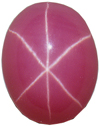SYNTHETIC STAR
CORUNDUM
It is amazing how people can
have such admiration for gemstones
created by nature, while at
the same time seeking to gain
a profit by imitating them.
Synthetic ruby was first commercially
manufactured in 1904. When
considering how humans can
make synthetic materials that
are structurally identical
to gemstones--- even making
them exhibit a star--- one
cannot help but appreciate
the power of technology. It
is even possible to control
such aspects as the appearance
of the star, as well as the
appearance, coloration, and
tone level of the material.
However, since the production
of synthetic stones can be
increased simply by expanding
facilities, their supply is
virtually infinite, and they
possess no rarity. Though they
may be used as components for
accessories, synthetic stones
are not gemstones. There is
almost no current demand for
these synthetic star sapphires
and synthetic star rubies.
There are also stones being
treated by scientifically diffusing
color- or star-causing agents
into the surface of natural
colorless corundum to produce
a blue color or a star (a process
known as surface diffusion
treatment). It appears that
such diffusion-treatment blue
sapphires have been sold in
the Thai gemstone-cutting center
of Chanthaburi in recent years.
There are totally different
from the above-mentioned synthetic
star sapphires, but since their
prices are cheap, measures
must be taken so that they
do not end up being mixed in
with natural material.
A professional jeweler can
positively distinguish between
natural and synthetic star
corundum. Modern gem identification
and separation techniques a
re advancing in leaps and bounds.
A specialist can separate natural
and synthetic by such means
as optical and compositional
analysis, as well as by looking
for evidence of natural crystal
growth. |
|
|
| Synthetic Star Sapphire |
 |
 |
| Size
(mm): L 9.0 x W 6.8 x D 3.32 |
| |
| Synthetic Star Ruby
(Translucent) |
 |
 |
| Size
(mm): L 9.0 x W 6.9 x D 3.50 |
| Synthetic Star Ruby
(Opaque) |
 |
 |
| Size
(mm): L 8.9 x W 7.0 x D 3.56 |
|
 |
JUDGING QUALITY
Just as with star ruby, star sapphire's
quality is judged based on beauty
and tone of color, and the pivotal
quality factor is whether the blue
color is distinct or not.
As far as the star's orientation
goes, cutters believe that if all
other factors are equal, it is better
to have the star centered along the
vertical axis (as in the gemstone
shown on the quality scale in 5-S)
rather than along the horizontal
axis (as in 2-S). A vertically centered
star will make the stone look larger
and more beautiful, increasing its
value. |
|